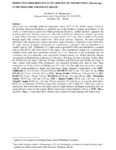Please use this identifier to cite or link to this item:
http://www.alice.cnptia.embrapa.br/alice/handle/doc/154343| Title: | Productive performance of 20 varieties of fodder nopal (Opuntia spp.) in the semi-arid Northeast, Brazil. |
| Authors: | ALBUQUERQUE, S. G. de  |
| Affiliation: | SEVERINO GONZAGA DE ALBUQUERQUE, CPATSA. |
| Date Issued: | 2004 |
| Citation: | In: CONGRESO NACIONAL, 10.; CONGRESO INTERNACIONAL SOBRE CONOCIMIENTO Y APROVECHAMIENTO DEL NOPAL Y OTRAS CACTACEAS DE VALOR ECONÓMICO, 8.; INTERNATIONAL CONGRESS ON CACTUS PEAR AND COCHINEAL, 5., 2004, Chapingo. Memorias... Chapingo: Universidad Autonoma Chapingo, 2004. |
| Description: | Due to poor soils and high minimum temperature (above 20.5o C), the ‘Sertão’ region, located in the Brazilian Semi-arid Northeast, is probably one of the harshest cropping environments in the world, in which nopal i s grown for f odder production. Recently, another problem appeared, the armored scale insect (Diaspis echinocacti - Bouchè). A field trial with twenty varieties was started in April 2000 in Petrolina, Pernambuco, (average rainfall 552.2 mm, 80% available in December through April). The varieties tested were: three local cultivars, ‘Gigante’, the most cultivated, ‘Redonda’ (both Opuntia ficus-indica) and ‘Doce’ nopal (Nopalea cochenillifera) and Clone IPA- 20, eight varieties of highest performance in a preliminary evaluation2, that are identified by a number such as, 1258 - Additional Cv.; eight varieties provided by IPA, and identified by a number such as, IPA-90-73, and n ever tested in the region.. The e xperimental design was, a randomized complete block, with four replications, in p lots of 3.5 m2, made up o f one seven-plant li ne, for evaluation, on ly five plants/line were c onsidered. Planting density was 20.000 p lants/ha. Manure was applied on biannual basis at the rate of 2.86 kg/m.. Weeding was done with hoes. In May 2004, the first harvest was done, collecting all fresh material except t he basal pad and the first l ayer of pads. Annual fresh matter (FM) production was calculated d ividing total yield by four. Mean production was 75.24 ± 33.61 ton FM/ha/year (CV = 44.7 %). The eight most productive varieties, with FM production/ha/year, h eight and transversal canopy diameter in p arenthesis were: 1258 - Additional cv. (115.25 ton; 1.50 and 0.96 m); IPA-90-73 (106.75 ton; 1.53 and 1.16 m); Clone IPA-20 (101.12 ton; 1.46 and 1.09 m); 1278 - Mexico Fodder (99.00 ton; 1.68 and 0.88 m); IPA- 90-155 (96.75 ton; 1.50 and 1.05 m); IPA-90-75 (86.92 ton; 1.32 and 1.00 m); 1311 - Marmillon Fodder (85.55 ton; 1.64 and 0.78 m); 1267 - Algeria Fodder (85.25 ton; 1.18 and 1.18 m). ‘Gigante’ nopal (68.00 ton; 1.43 and 1.05 m) stayed in 13 o position, as in research cited b elow. There was no d ifference (P<0.05) among these treatments, du e to h igh CV. Other data, such as, protein and fiber levels, that are still under analysis, might indicate that highest production does not assure the best variety for the region. Shorter transversal canopy diameter such as in 1278 - Mex... and 1311 - Mar..., would make these varieties more suitable for intercropping with annual crop |
| Thesagro: | Produção Variedade |
| NAL Thesaurus: | Opuntia Forage |
| Keywords: | Palma Opuntia spp Nordeste Região semi-árida |
| Type of Material: | Resumo em anais e proceedings |
| Access: | openAccess |
| Appears in Collections: | Resumo em anais de congresso (CPATSA)  |
Files in This Item:
| File | Description | Size | Format | |
|---|---|---|---|---|
| OPB829.pdf | 47.99 kB | Adobe PDF |  View/Open |









